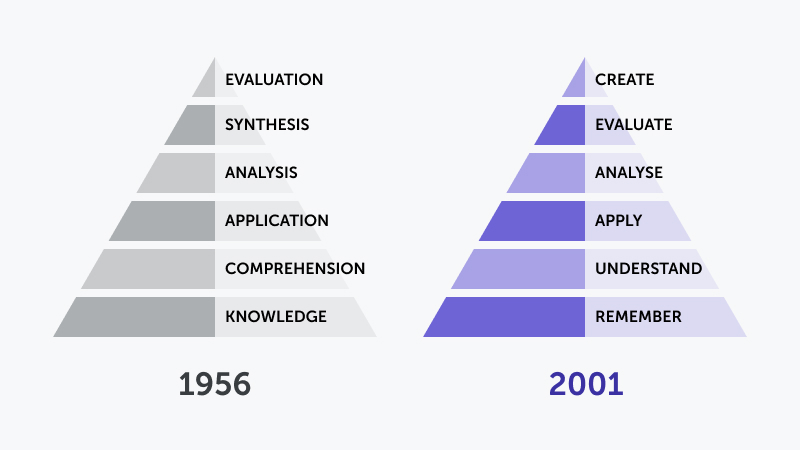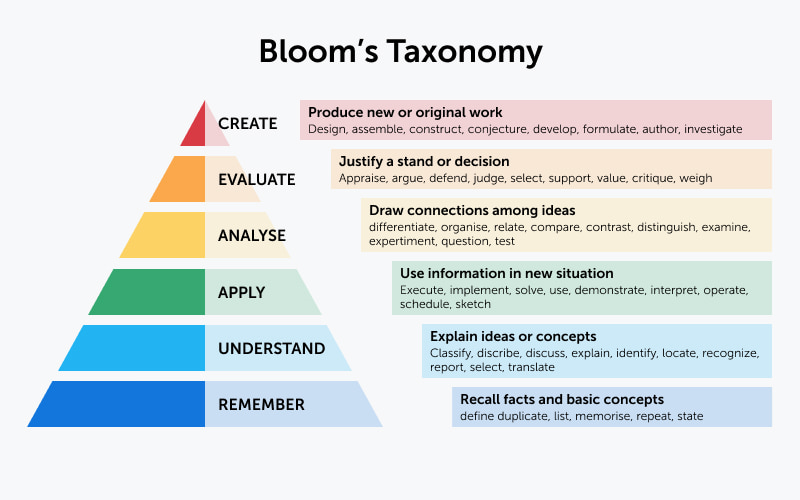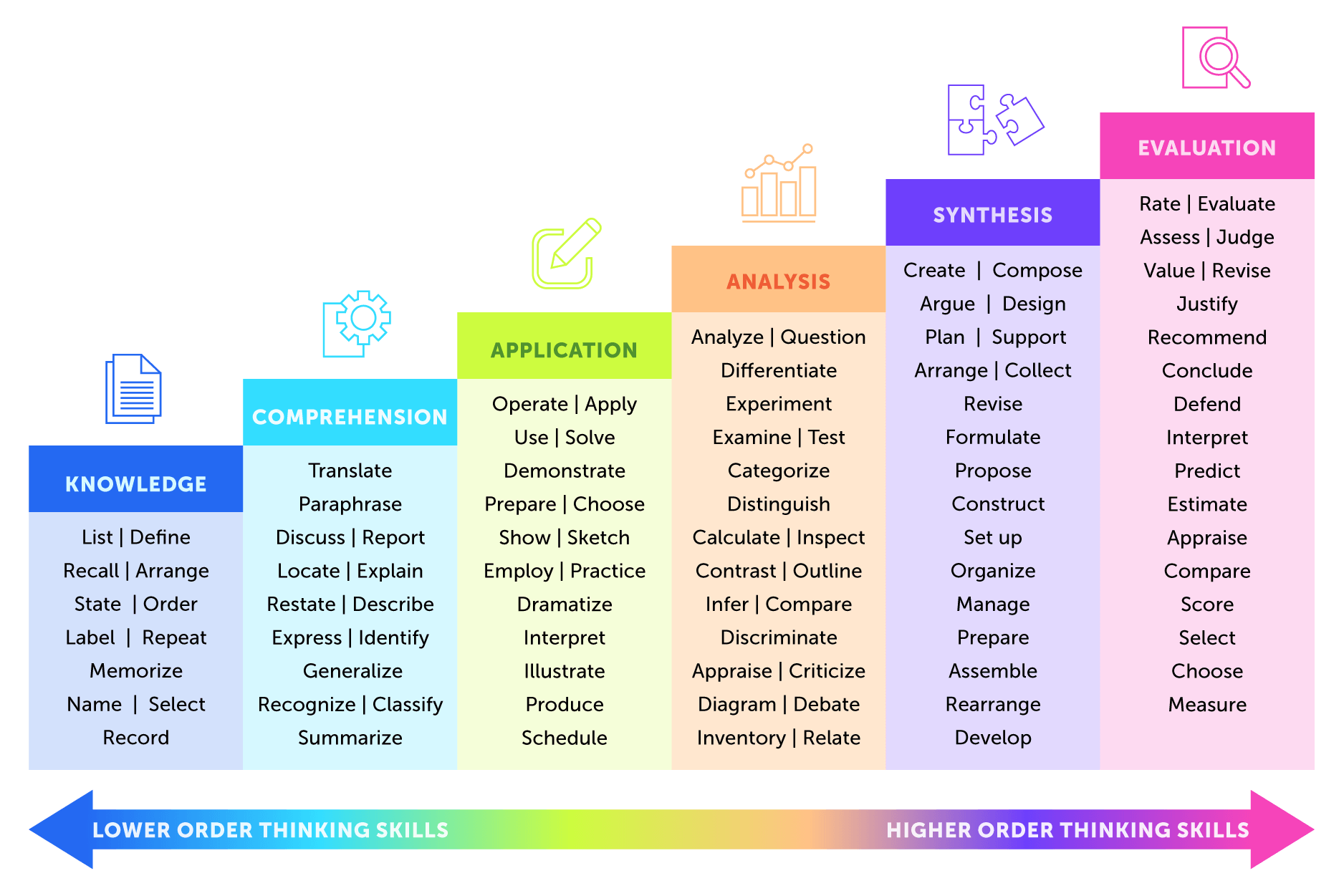Are you trying to teach people without identifying educational objectives?
If you keep doing that, your learners may waste their time succeeding in things that are of no use to them. To avoid that, clarify your instructional goals using Bloom’s Taxonomy.
This article will help you learn:
What is Bloom’s Taxonomy?
Original Bloom’s Taxonomy
Revised Bloom’s Taxonomy
Bloom’s Taxonomy levels
Why Bloom’s Taxonomy is important?
Bloom’s Taxonomy verbs
Original Bloom’s Taxonomy
Revised Bloom’s Taxonomy
Bloom’s Taxonomy levels
Why Bloom’s Taxonomy is important?
Bloom’s Taxonomy verbs
What is Bloom’s Taxonomy?
Bloom’s Taxonomy attempts to classify learning stages from remembering facts to creating new ideas based on the acquired knowledge.
The idea of Bloom’s Taxonomy is that learning is a consecutive process. Before applying a concept in real life, we must understand it. Before we understand a concept, we must remember the key facts related to it.
Therefore, although initially described as a framework, it is now often depicted as a pyramid.
The basis of the pyramid is Knowledge, the first level of learning. Above it lies Comprehension, Application, Analysis, Synthesis and Evaluation. Each level above builds upon the one below, so you can only move up the pyramid one step at a time.
The original taxonomy was first described in 1956 in the book Taxonomy of Educational Objectives by American educational psychologist Benjamin Bloom and his coauthors Max Englehart, Edward Furst, Walter Hill, and David Krathwohl. Their book classifies learning goals into one of the categories mentioned above (from Knowledge to Evaluation).
Their goal was to provide teachers with a common vocabulary to discuss curricular and evaluation problems with greater precision.
The language teachers had been using to explain what they expected of their students was, according to the authors, no more than “nebulous terms.”
“For example, some teachers believe their students should ‘really understand,’ others desire their students to internalize knowledge, still others want their students to grasp the core or essence or comprehend. Do they all mean the same thing?” asked the authors.
The taxonomy of educational objectives was supposed to help teachers speak the same language and thus “facilitate the exchange of information about their curricular developments and evaluation devices.”
Though it was designed primarily for college professors, it finally became popular among educators, from K-12 teachers to corporate trainers.
Since its publication, the book has been translated into more than twenty languages and is now used for instructional design worldwide. However, it is currently more often applied in its revised version.

To provide learners with clearer instructional goals, a group of researchers led by Bloom’s colleague David Krathwohl and one of Bloom’s students, Lorin Anderson, revised the taxonomy in 2001.

In the new variant, nouns were replaced by action verbs. Also, the two highest levels of the taxonomy were swapped. The new learning stages are Remember, Understand, Apply, Analyze, Evaluate and Create. The authors also defined cognitive processes associated with these instructional goals. For example, the ability to remember requires recognizing and recalling.
Let’s take a closer look at each learning stage, based on the book describing the revised framework A Taxonomy For Learning, Teaching and Assessing by Krahtwohl and Anderson. The authors recommend reading the name of each learning category as though preceded by the phrase “The student is able to…” or “The student learns to…”
This stage of learning is about memorizing basic facts, dates, events, persons, places, concepts and patterns.
At this level, educators might ask learners simple questions like:
What are the most spoken languages of Latin America?
What is the chemical formula of water?
Who was the first president of the United States?
The associated cognitive processes, as already noted, are:
What is the chemical formula of water?
Who was the first president of the United States?
The associated cognitive processes, as already noted, are:
Recognizing means locating knowledge in long-term memory related to presented material
(e.g., recognizing the dates of important historical events).
Recalling is retrieving knowledge from long-term memory
(e.g., recalling the dates of important historical events).
2. Understand
At this point, learners might be asked to explain a concept in their own words, describe a mathematical graph or clarify a metaphor.
The processes associated with understanding are:Interpreting implies changing from one form of representation to another. It might be transforming numerical information into verbal.
Classifying is determining a category of something. An example is the classification of mental disorders.
Summarizing means retrieving a general theme of significant points (e.g., writing a short summary of a story).
Inferring is drawing a logical conclusion from given information. It may be formulating grammatical principles of a foreign language from the presented examples.
Comparing is finding correspondences between two ideas or objects (e.g., comparing historical events to their contemporary analogues).
Explaining is constructing a cause-and-effect model of a system, for example, explaining the causes of the French Revolution.
3. Apply
Now, it’s time to use learned facts and abstractions in new contexts and particular situations.
For example, students might be asked to discuss phenomena described in one scientific paper using terms and concepts of another paper.
The processes of cognition corresponding to this stage are:
Executing is applying a procedure to a familiar task
(e.g., calculating the root of a number).
Implementing is about applying a procedure to an unfamiliar task (e.g., using Newton’s Second Law in a new situation).
4. Analyze
At this level, students are supposed to break down concepts and examine their relationships.
For instance, they might be asked to recognize the genre of a painting or describe the leading causes of the Great Depression.
The three particular processes associated with this stage are:
Differentiating means distinguishing important from unimportant parts of presented material
(e.g., distinguishing between relevant and irrelevant numbers in a mathematical word problem).
Organizing involves identifying how elements fit or function within a structure
(e.g., finding the hypothesis, method, data and conclusion in a research report).
Attributing means determining a point of view, bias, values, or intent underlying presented material. An example would be to identify the author’s point of view of an essay.
In this stage, learners are expected to use their knowledge and skills to appraise a situation, justify their stand or criticize others’ opinions. They should be able to point out logical fallacies in arguments or compare a work to the highest standards in its field.
They might be asked, for example:
In your opinion, is online piracy ethical?
Do you consider jazz music to be high art?
What are the most absurd arguments against vegetarianism?
Do you consider jazz music to be high art?
What are the most absurd arguments against vegetarianism?
Evaluating is divided into checking and critiquing.Checking means detecting inconsistencies or fallacies in a process or product.
For example, it’s determining if a scientist’s conclusions follow from observed data.
Critiquing involves finding inconsistencies between a product and external criteria. For instance, it’s judging which of two methods is the best for solving a problem.
6. Create
This is the most complex stage of the learning process and the top of the revised Bloom’s Taxonomy.
At this level, learners combine known patterns, ideas and facts to create original work or formulate their solution to a problem.
They might be asked to compose a song, rewrite a story in another setting or formulate a hypothesis and propose a way of testing it.
The three associated cognitive processes are:Generating involves coming up with alternative hypotheses based on criteria. An example might be devising multiple solutions for a social problem.
Planning is about coming up with a procedure for completing a task (e.g., preparing an outline of an article).
Producing means inventing a product
(e.g., writing a short story that takes place during the American Revolution).
Why Bloom’s Taxonomy is important
Bloom’s Taxonomy can help educators map learning within a single lesson or even a whole course.
Using the taxonomy as a guide, trainers can identify clear instructional goals corresponding to each taxonomy level and create plans to achieve them.
By setting achievable objectives for learners, instructors make them more active and responsible for their education.
The taxonomy can also be useful for evaluating learners correctly. An essay, for example, is probably not the best form of testing when learners only need to remember basic facts and terminology related to the topic.
But it will be appropriate at the evaluation stage when they are expected to formulate their opinion on an issue.
Bloom’s taxonomy allows educators to gauge the learners’ progress. It helps teachers determine which level every learner is on and assign them an individual task.
Bloom’s Taxonomy verbs
When talking about Bloom’s taxonomy, action verbs associated with the categories and cognitive processes are often mentioned. Instructors use these verbs to describe activities required for achieving educational objectives corresponding to each level.
For instance, at the analyzing level, the Azusa Pacific University recommends using verbs like “compare”, “distinguish”, and “simplify” when formulating instructional tasks.
There is a list of Bloom’s taxonomy verbs, created by the University of Arkansas. Using these verbs can help learners explicitly navigate what they must do to demonstrate their mastery of the objective.

However, neither Bloom’s original book nor his followers’ book contains a list of such verbs. The authors of a study of 47 verb lists collected from 35 universities and textbooks note: “There was very little agreement between these lists, most of which were not supported by evidence explaining where the verbs came from.”
Nevertheless, given that such lists of verbs are being created anyway, the authors identified verbs that appeared in more than 50% of the listings. Then they identified verbs for which 50% of their appearances were in one specific tier. Using these verbs, the authors constructed “A Master List of Action Verbs for Learning Outcomes.”
No comments:
Post a Comment